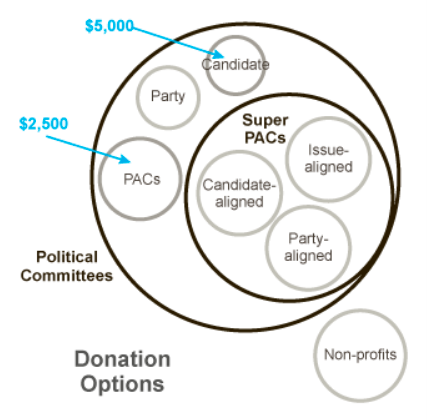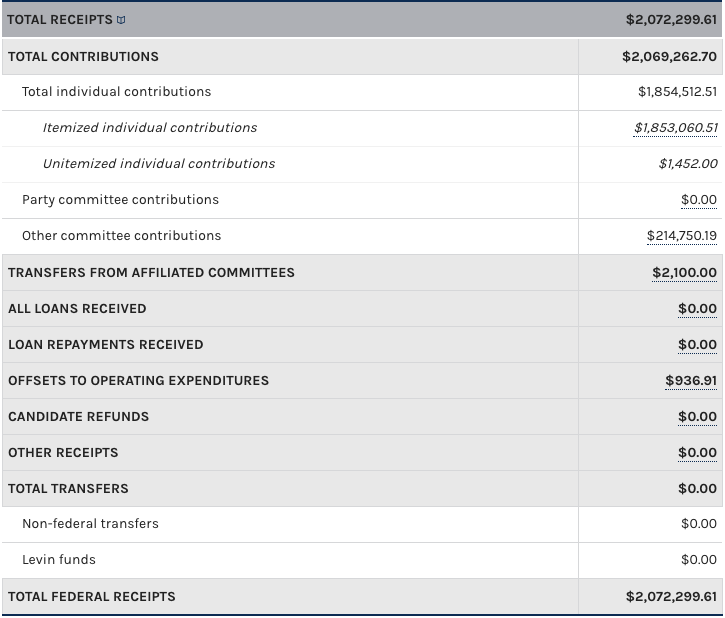A Roadmap for understanding campaign finance

|
This diagram is from a 2014 interactive article in the NYTimes. It is a great place to start understanding the effect of money in our politics. The limits on contributions are indexed to inflation, so the illustrated limits are now higher, e.g. $5400 can be given directly to a Candidate’s election committee ($2700 for the Primary and $2700 for the General election), and a conventional political action committee (PAC) can receive $5000 from an individual donor. |
McMorris Rodgers American Dream Project campaign fund receipts for January 1,2017 to March 31, 2018
|
Dear Group, Orientation: Yesterday in Part I, we looked at McMorris Rodgers individual campaign coffer, Cathy McMorris Rodgers for Congress. The take home message is 1) a lot of her money comes from corporate PACs, 2) she has fewer donors than Lisa Brown who give larger amounts of money, 3) on account of well-meaning campaign finance laws limiting the size of the donations, what you see in Cathy McMorris Rodgers for Congress does not necessary represent the full financial clout wielded by the donors. Seeing that requires more sleuthing. Look at above diagram. In today’s post we are still just looking at those three categories in the upper left part of the diagram, Candidate, Party, and PAC political committees. We haven’t even had a whiff of the money unleashed by Citizens United. What we are looking at so far is only the money sloshing in the traditional, pre-Citizens United efforts to get around campaign finance law. While combing through Cathy McMorris Rodgers for Congress, I ran onto MCMORRIS RODGERS AMERICAN DREAM PROJECT; THE (C00543199). This is a traditional Political Action Committee. It is sub-classified as “NonQualified – Joint Fundraising Committee.” It is non-qualified because being “qualified” requires that the PAC contribute to at least five federal candidates. The American Dream Project contributes to only three: Cathy McMorris Rodgers for Congress, the NRCC (National Republican Congressional Committee), and yet another McMorris Rodgers PAC, “CMR POLITICAL ACTION COMMITTEE (C00469429)“ Do you get a sense of the complexity…and the intertwining…of all these PACs wielded by McMorris Rodgers? I encourage you to visit the American Dream Project website. In light of what is going on in the federal government today the rhetoric on this website made my skin crawl. Here’s an example: “It is the Cathy McMorris Rodgers joint fundraising committee to help recruit and fund candidates who believe in the American Dream and want to make America a land of opportunity, again.” So the “American Dream,” is, I guess, code for repealing the Affordable Care Act, passing a tax bill that rewards corporations and the rich, exploiting the Arctic National Wildlife Refuge (ANWR), and dismantling the social safety net using the excuse that, now that we’ve rewarded the rich, well, now we’re broke. The MR American Dream Project PAC accepts large donations and makes them legal by breaking them up and passing them through to the three recipients listed in the third paragraph above. I guess if you are a major business owner in the 5th Congressional Distrcit, you happen to have $300,000 you wish to contribute to this “Dream,” and you don’t mind having your name on the FEC website, this is really convenient. You and your wife just write a couple of checks for 150K and let the American Dream Project parcel the money out and keep it all legal. Under FAQs on the American Dream Project website you can see how it’s done, although their posted contribution limits are outdated. The updated limits would send $5400 ($2700 X2) to CMR’s individual coffer, CMR for Congress. The next $5000 goes to the CMR PAC, then $33,800 to the National Republican Congressional Committee. For a $150,000 personal donation I haven’t yet worked out where the Dream sends the excess $105,800 dollars and keeps it legal, but I’m sure there’s a way. I encourage you to visit the list of donors to the Dream, Click the “Amount” column heading on the right to sort the 265 unique contributions by size. There will be names you’ll recognize. Click the names to learn the contributor’s employment details, presumably an indicator of the business that made the contributor wealthy enough to contribute this money. Ask yourself what they hope to get in return. PAY ATTENTION: We’re still only talking about that part of the campaign finance picture represented by the circles in the crescent in the diagram above. We haven’t even glimpsed superPAC and Dark Money. Here’s a really sobering fact: in the midterm election cycle (2 years) only 0.33 percent (1 of 300) U.S.adults makes a contribution of $200 or greater to ANY political candidate, party, or Political Action Committee. (I believe this is federal only, not state or local.) These >$200 donors provide 2/3 of all campaign funding (1/3 comes in smaller amounts). Ask yourself what a $300,000 donation must buy. Finally, recognize that these unimaginably wealthy mega-donors are just the ones willing to be publicly identified on the FEC website. We haven’t glanced at SuperPACs or at the dark money.wielded in the non-profit sector. More in Part III. Keep to the high ground, Jerry |